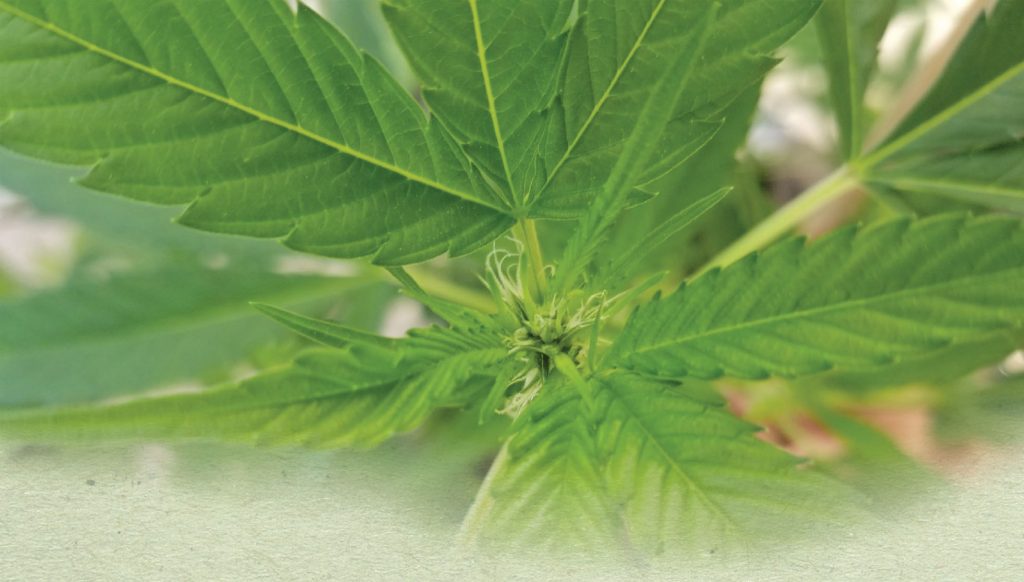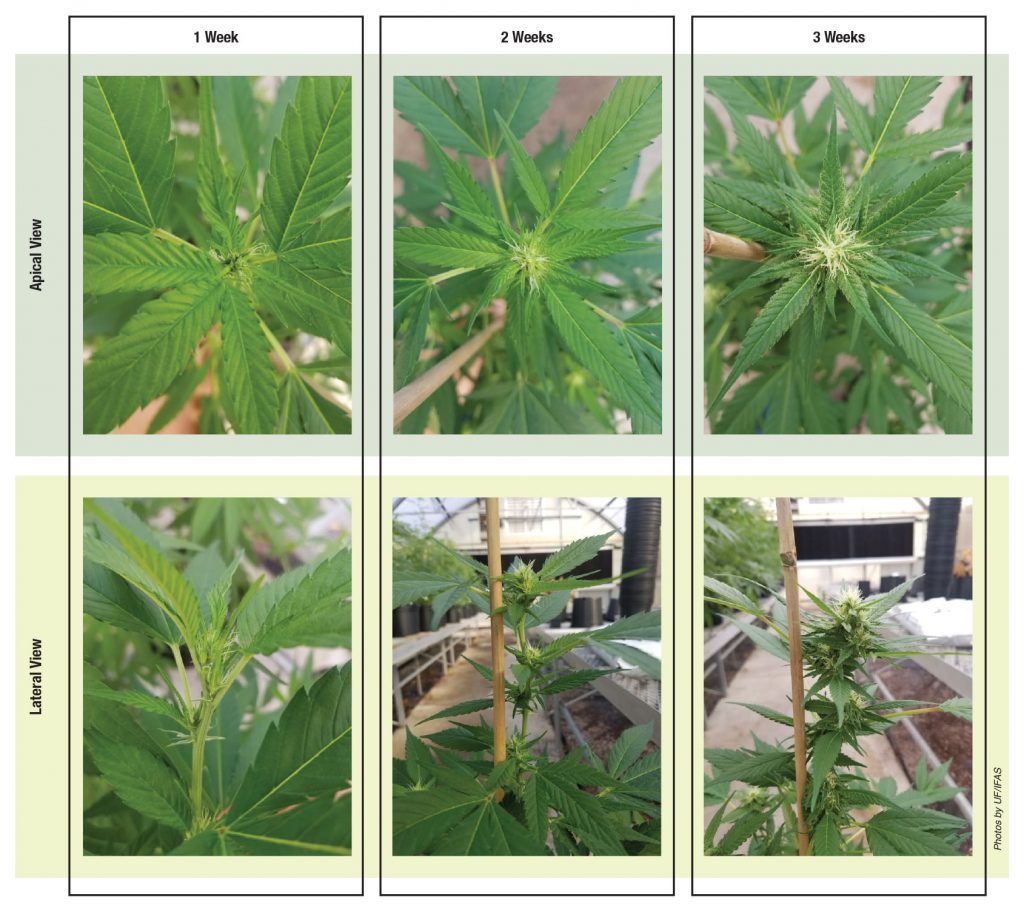
By Tory Moore
As the University of Florida Institute of Food and Agricultural Sciences (UF/IFAS) Industrial Hemp Pilot Project research continues, growers around the state have begun growing hemp on their own farms. Researchers from the UF/IFAS Mid-Florida Research and Education Center (MREC) in Apopka have important considerations for Florida growers contemplating or currently growing hemp. Research lessons learned and new findings are the focus of this article.
FLOWERING REQUIREMENTS
Understanding hemp genetics, specifically flowering requirements, before you plant is vitally important.
Hemp is predominantly a short-day, photoperiod-sensitive plant. In controlled environments like greenhouses, hemp is commonly grown under 18 hours of light to keep plants in a vegetative phase and then transitioned to 12 hours of light to initiate flowering. Supplemental lighting is necessary to maintain plants in a vegetative state when natural daylength is below the daylength that initiates flowering. Photoperiod requirements vary among hemp varieties and cultivars.
Genetics determine whether flowering in a particular variety or cultivar is daylength dependent or daylength neutral (known as autoflowering).
Daylength-dependent varieties and cultivars flower when daylength shortens to a critical threshold and triggers flowering. This is somewhere between 12 to 15 hours of daylight, depending on the variety or cultivar. Florida has between 13 to 14 hours of daylight on the longest day of the year, the summer solstice on June 21, which limits optimal planting time to within a few weeks of the solstice. Beyond optimal planting dates, plants can reach a desirable size if grown vegetatively under lights for three to six weeks prior to transplanting or removal from supplemental lighting. However, this is dependent upon the growth rate and plant architecture of the variety or cultivar.
Daylength-neutral or autoflowering varieties and cultivars will flower after a specific maturity time, commonly 30 to 50 days after sowing. Autoflowering hemp plants are generally smaller and can be planted at higher densities, with some reports of seeding rates of up to 26,000 plants per acre.
Take time to learn what the early stages of flowering look like so you can accurately track flower development. Flower bulking is noticeable starting around two to three weeks.
Weekly or twice weekly, sampling of upper plant flowers and other plant tissue should be conducted after flowering has begun. Sample to ensure the crop does not exceed the 0.3 percent limit for total Delta-9 THC, commonly known as “going hot.” High floral density can be achieved by six to eight weeks after floral initiation.

Most high-cannabinoid hemp cultivars are dioecious, meaning plants are either male or female. Only female hemp plants produce desirable flowers and high-cannabinoid extract. When fertilized by male pollen, female plants produce seeds and produce less oil. It is critical to determine plant sex when cultivating essential oil-type hemp to prevent accidental production and pollination by male plants, which would reduce high-cannabinoid production ideal for CBD and CBG products.
PEST MANAGEMENT
Consider pest management early and evaluate pest pressure in your hemp crop often.
You will encounter pests within your hemp crop. Commonly found pests include aphids, mites, arthropods (grasshoppers) and worms (tobacco budworm, corn earworm and beet armyworm).
Weekly scouting for pests is recommended with special attention being made during flowering. Worm pressure is most noticeable during flowering and can devastate a hemp crop. If you identify your plants transitioning, be prepared for worm pressure.
Pesticides available for use in hemp are limited. UF/IFAS recommends testing approved pesticides on a few plants to see if the products cause harm before treating the entire crop. Growers will want to be prepared to spray as soon as they see a need, so conducting this testing before a problem arises is critical. Since there are a lack of conventional pesticides available for use in hemp, be sure to know what pest control products are approved by the Florida Department of Agriculture and Consumer Services.
Fungal issues in hemp have been observed both in greenhouse and field trials.
IRRIGATION AND FERILIZATION
Hemp needs adequate water for optimal growth but does not like “wet feet.” Hemp sitting in water for just a day or two can promote virulent fungi and kill plants.
Selection of appropriate growth media or field space is critical to keep plants healthy. Keep in mind that hemp cultivars have varying water demands and tolerance. Dialing in your irrigation will be critically important for success.
Preliminary findings for greenhouse-grown hemp suggest that plants can be grown in a wide variety of substrates. Hemp in container production seems to favor substrates with greater porosity (air space). Plants perform poorly in substrates that stay too wet, as root rot has been observed in other substrates.
If fertigating, low fertigation on a consistent basis is advised to reduce leaching through the soil.
In potted studies, significant losses were seen at soil electrical conductivity of 1.9 or greater. If fertigation is not possible, consistent results can be achieved with appropriate amounts of granular fertilizer.
ADDITIONAL ADVICE
If taking vegetative cuttings of the crop, the selection of proper rooting media is critical. Always use a rooting hormone to increase rooting success. Hormone concentrations that are too high can reduce rooting success; 1,000 parts per million indole-3-butyric acid tends to work well.
Florida has unique growing conditions and pressures that make producing any new crop a challenge. Along with UF/IFAS Industrial Hemp Pilot Project information, rely on those successfully growing hemp in your area to provide data-driven and specific production advice. If you have not yet begun to grow hemp, consider the rules and regulations as well as the inherent risks of growing any new crop.
Hemp production lacks a body of knowledge validated by years of scientific research and data, much of which the UF/IFAS Industrial Hemp Pilot Program actively seeks to develop. UF/IFAS researchers recommend growers make hemp cultivation and management decisions and choose genetics based on information appropriate to their region and backed by science.
UF/IFAS Extension agents across the state are available for support and to answer questions tailored to your region and farm. The UF/IFAS Industrial Hemp Pilot Project website (programs.ifas.ufl.edu/hemp) is updated regularly with the latest research results and ways to learn more about growing hemp in Florida.
Acknowledgments: Steven Anderson, Brandon White, Brian Pearson and Roger Kjelgren contributed to this article.









